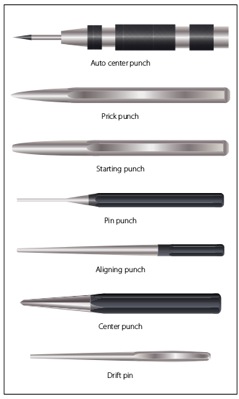Blog
Types of Punches and Their Uses

Mechanical engineering workshops extensively use various types of punches. Few of the basic types include center punch, prick punch, pin punch and drift punch. Workshops use punches for locating centers for drawing circles, to punch holes in sheet metals, to start holes for drilling, to remove damaged rivets, bolts or pins and to transfer location of holes in patterns. Some punches used are hollow.
Classification and Use of Punches
Punches are usually classified according to the shape of their points. The most commonly used among these is the prick punch, useful for placing reference marks on metal. You can use this to transfer dimensions from a paper pattern directly on to the metal. For this, you will need to place the paper pattern directly on the metal and orient it correctly.
Now, go over the outline of the pattern with the prick punch. Tap it lightly with a small hammer so that the punch makes slight indentations on the metal at major points on the drawing. Use these indentations as reference marks for cutting the metal. Be careful never to strike a heavy blow with the hammer as it may cause the prick punch to bend or even damage the work material excessively.
A center punch is useful when making large indentations in metal, such as necessary to engage a twist drill. Take care that you do not strike with so much force as to cause the end to protrude through or dimple the metal around the indentation. Usually, a center punch is heavier than a prick punch and has a point ground to an angle of 60º.
For driving out damaged rivets, bolts and pins that are bound up in holes, you should use the drive punch. The drive punch has a flat face instead of a point. The width of its face defines this type of punch, for example, 1/8-in or 1/4-in. The sides of a drive punch will taper all the way down to the face, but sometimes you may need to use a punch with a straight shank. This is called the pin or drift punch.
In practice, you first use a drive punch to drive the pin or bolt that is to be removed until the hole blocks the progress of the punch. You then use a pin punch to drive the bolt or pin the rest of the way until it is ejected from the hole. Be careful not to use a prick or a center punch to remove bolts or pins from holes, as the point of the punch will spread the object making it even more difficult to remove.
When necessary to fit a drill-locating hole in a template, you must use a transfer punch. The transfer punch is typically about 4-inches long and has a point that initially tapers, then runs straight for a short distance. The tip of the transfer punch is similar to that of a prick punch. True to its name, the transfer punch is useful for transferring the location of holes through a pattern or a template on to the metal.

